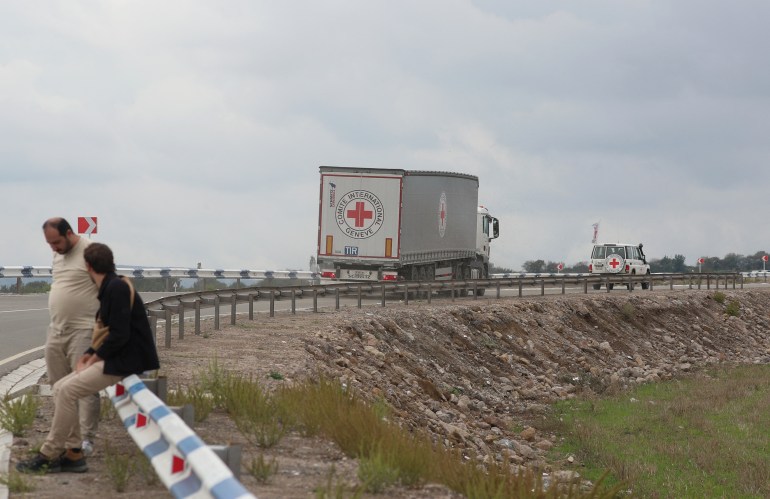Armenian separatists have begun laying down their weapons, as the first convoy of humanitarian aid entered Nagorno-Karabakh days after a Russian-brokered ceasefire deal ended Azerbaijan’s offensive this week.
“We are in close cooperation with the Russian peacekeepers, conducting the demilitarisation” of the separatists, Azerbaijan Ministry of Defence spokesman Anar Eyvazov told reporters in Shusha on Saturday, a district on the edge of the rebel stronghold of Stepanakert.
“We have already seized weapons and ammunition,” Eyvazov said, adding that its soldiers along with Russian peacekeepers are working jointly to disarm separatist fighters in the Nagorno-Karabakh region – home to more than 100,000 ethnic Armenians. Karabakh is recognised internationally as part of Azerbaijan.
Azerbaijan launched a lightning offensive on Tuesday on ethnic Armenian rebel positions in what it called an “anti-terrorist operation“. It demanded they lay down their arms and the separatist government disband.
With Armenians suffering serious shortages of food and fuel after a months-long de facto Azerbaijani blockade, an aid convoy of the International Committee of the Red Cross (ICRC) headed into Karabakh on Saturday, the first since Azerbaijan’s military operation.
The ICRC said in a later statement that the convoy had transported nearly 70 tonnes of humanitarian supplies, including wheat flour, salt and sunflower oil, along the Lachin corridor, the only highway connecting Armenia and the mountainous Nagorno-Karabakh region.
An ICRC team also carried out the medical evacuation of 17 people wounded during the fighting, it said.
Separately, Russia said it had delivered more than 50 tonnes of food and other aid to Karabakh.
More than 20 other aid trucks, bearing Armenian number plates, have been lined up along a nearby roadside since July. Azerbaijan said at the time that this convoy amounted to a “provocation” and an attack on its territorial integrity.
The ethnic Armenian leadership said that the terms of their ceasefire with Azerbaijan were being implemented, with work proceeding on the delivery of humanitarian aid and evacuation of the wounded.
Work was under way to restore the electricity supply by September 24, it said in a statement.
Armenians as ‘equal citizens’
Russia’s defence ministry said that, under the terms of the ceasefire, the Armenian separatists had begun handing over their weapons to Azerbaijan, including more than 800 guns and six armoured vehicles. Moscow has 2,000 peacekeepers in the area.
Russia deployed several thousand peacekeepers to the region in the wake of a brief but brutal 2020 war in which Azerbaijan reclaimed large parts of the territory and its surroundings from the separatists.
Azerbaijan intends to integrate the long-contested region, but ethnic Armenians have said they feared they will be persecuted and have accused the world of abandoning them.
But Azerbaijan’s foreign minister in his UN General Assembly address on Saturday said his country wants to integrate ethnic Armenians as “equal citizens”.
“I wish to reiterate that Azerbaijan is determined to reintegrate ethnic Armenian residents of the Karabakh region of Azerbaijan as equal citizens,” Jeyhun Bayramov said.
He added that Azerbaijan and Armenia have a “historic opportunity” to establish good neighbourly relations and co-exist side by side in peace. It is high time to seize this opportunity.”
Backing the ceasefire in Nagorno-Karabakh, Russia’s Foreign Minister Sergei Lavrov said that time was ripe for trust-building measures between Armenia and Azerbaijan, adding that Moscow’s troops would help that.
In his address at the UN, Lavrov accused the West of trying to force themselves as mediators between the two countries, which he said was not needed.

US delegation in Armenia
Meanwhile, a US congressional delegation was in Armenia to meet Prime Minister Nikol Pashinyan and travelled up to the closed border to inspect the blockade with the head of Armenia’s Syunik region.
Senator Gary Peters of Michigan used binoculars to look across the border towards Russian peacekeeper positions, as Azerbaijani trucks could be seen transporting material for a new highway being built as the government secures the region.
“Certainly, people are very fearful of what could be occurring in there, and I think the world needs to know exactly what’s happening,” Peters told reporters at the border.
“We’ve heard from the Azerbaijani government that there’s nothing to see, nothing to worry about. If that’s the case, we should allow international observers in to see for themselves,” he argued.
Anna Ohanyan, a professor at Stonehill College in Massachusetts, saw the visit by the US delegation in “multiple respects”.
“The situation is very dire in the region and the implications of the massive humanitarian crisis and the militarised ending for this conflict is going to reverberate in South Caucasus,” she said.
“I see the visit by the US delegation as a way for the US to try to reclaim some ability to shape the region.”









